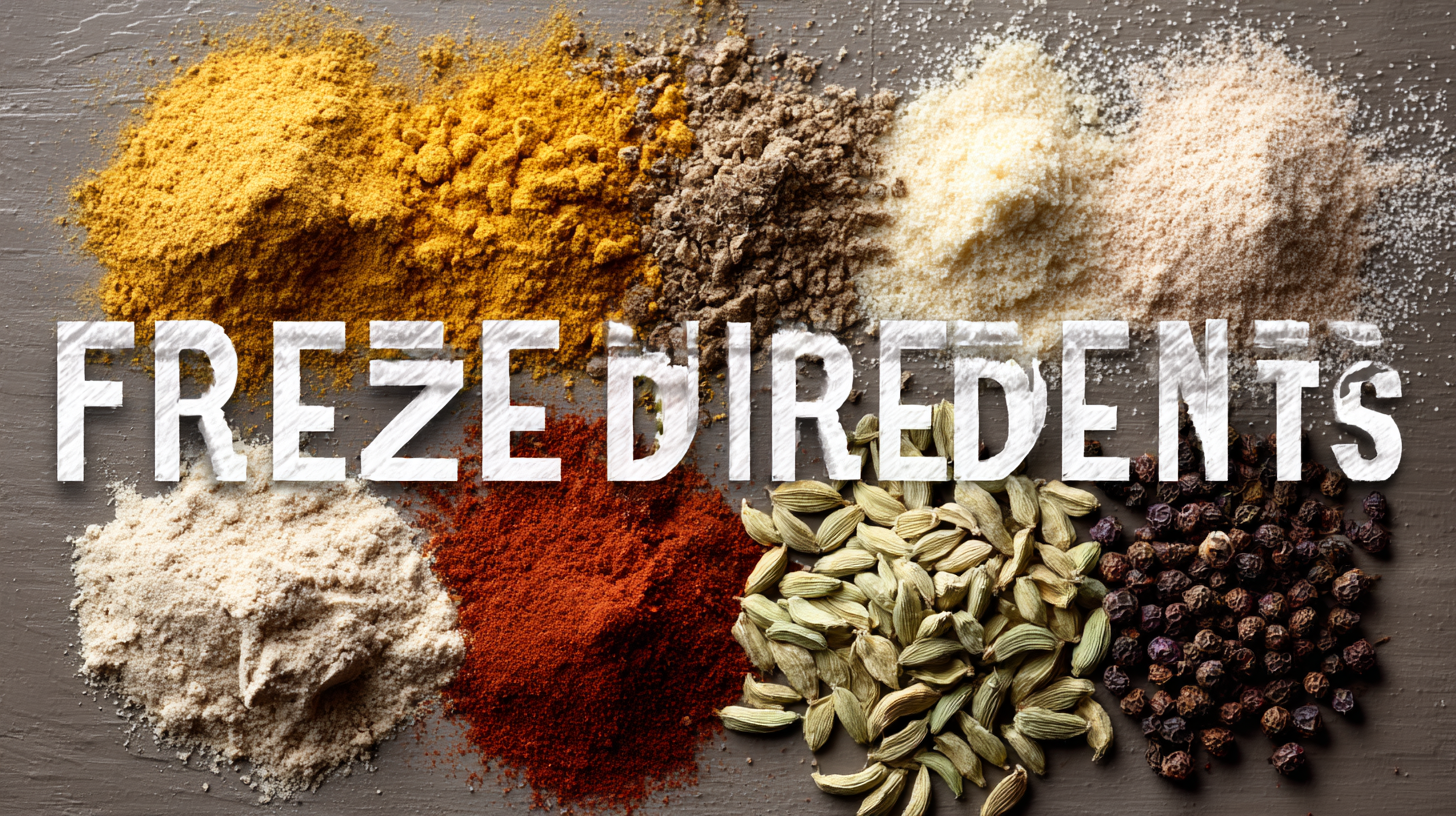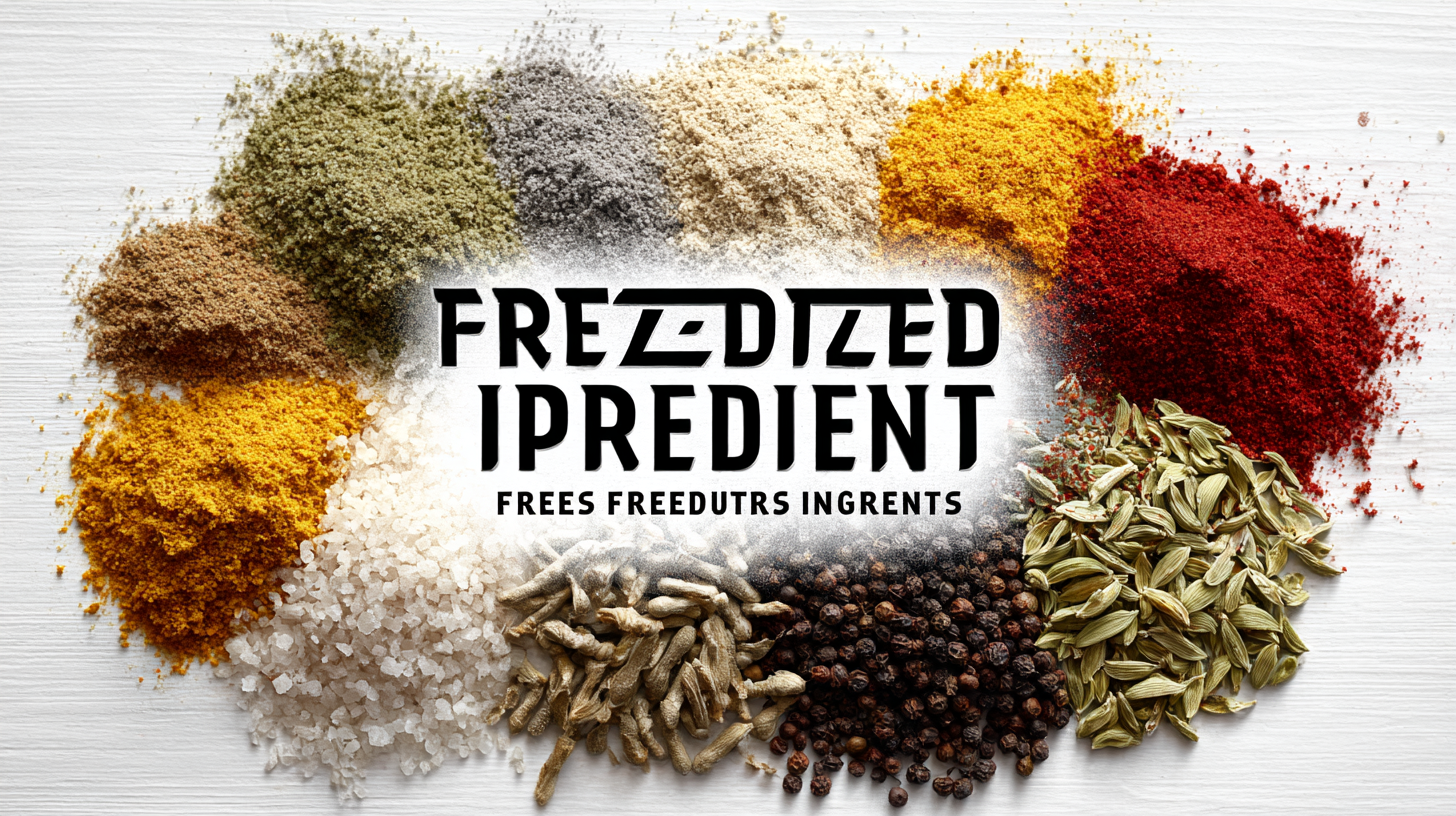As we look ahead to 2025, the demand for freeze dried ingredients is poised to experience significant growth, driven by changing consumer preferences and advancements in food preservation technology. According to a recent market research report by Grand View Research, the global freeze dried food market is expected to reach USD 76.3 billion by 2025, growing at a CAGR of 7.5% from 2019 to 2025. This trend is largely fueled by the increasing popularity of healthy and convenient food options, particularly among millennials. Additionally, as the food industry becomes more focused on sustainability and reduced food waste, freeze dried ingredients offer an attractive solution due to their extended shelf life and minimal environmental impact. In this blog, we will explore the upcoming market trends in freeze dried ingredients and provide a checklist for businesses looking to leverage these insights for future success.

The freeze-dried ingredients market is poised for significant growth in the coming years, driven by increasing consumer demand for convenient and nutritious food options. According to a recent analysis, the freeze-dried fruits and vegetables market is anticipated to reach USD 18.06 billion by 2034, exhibiting a remarkable CAGR of 11.9% between 2025 and 2034. This surge is fueled by the rising use of freeze-dried products in various sectors, including health foods, snacks, and ready-to-eat meals, as consumers increasingly prioritize food that retains its nutritional value while being shelf-stable.
Furthermore, the overall freeze-dried food market is also expected to benefit from trends in health consciousness among consumers. By 2034, it is projected that the USA will account for approximately 80% of North America's freeze-dried food market revenue, highlighting a significant regional demand. As businesses look to capitalize on these trends, understanding these statistics and industry projections will be crucial. Companies can leverage technological advancements in freeze-drying processes and innovate product offerings to capture a share of this expanding market, aligning with consumer preferences for healthful and convenient food solutions.
| Ingredient Type | Projected Market Size (USD Million) | Growth Rate (CAGR) | Key Applications |
|---|---|---|---|
| Fruits | 450 | 8% | Snacks, Smoothies |
| Vegetables | 370 | 7% | Soups, Ready Meals |
| Meats | 320 | 6% | Pet Food, Camping Meals |
| Dairy | 210 | 5% | Beverages, Snacks |
| Herbs & Spices | 150 | 10% | Cooking, Seasoning |
As we look towards 2025, consumer preferences for freeze-dried foods and ingredients are evolving rapidly. Health-conscious consumers are increasingly seeking lightweight, nutritious options that fit into their on-the-go lifestyles. This trend is reflected in the growing demand for organic and non-GMO freeze-dried ingredients, as individuals become more aware of the importance of clean eating. Additionally, the convenience of adding freeze-dried fruits and vegetables to meals without the need for elaborate preparation makes them highly appealing to busy families.

Moreover, the rising popularity of plant-based diets is influencing the freeze-dried market considerably. As more people incorporate vegetarian and vegan options into their diets, the demand for freeze-dried legumes, grains, and plant-based proteins is surging. This aligns with a broader trend of sustainability, as consumers prioritize brands that utilize eco-friendly methods and offer responsibly sourced ingredients. Companies that can adapt to these changing preferences and innovate in product offerings will be well-positioned to capture the expanding market in the upcoming years.
The freeze-drying sector is poised for significant advancements, particularly driven by technological innovations in 2025. This is underscored by the Food Lyophilization Equipment Market, projected to reach $1.60 billion by 2030, reflecting a growing demand for high-quality freeze-dried ingredients. Technological advancements, such as microwave vacuum freeze-drying and ultrasonication pre-treatments, are set to enhance the preservation of bioactive compounds and the overall quality of freeze-dried products. For instance, these technologies can effectively retain the nutritional value in food items, maximizing consumer appeal.
Moreover, the increasing focus on revalorizing tomato processing by-products highlights the potential for utilizing advanced drying techniques to extract valuable nutrients. The integration of energy-carrying electromagnetic fields in drying processes represents a frontier for improving efficiency and quality. As the industry embraces these innovations, it is essential for stakeholders to stay informed about evolving methods and leverage them to meet the rising consumer demand for high-quality, nutrient-rich freeze-dried ingredients.
As we look ahead to 2025, the demand for freeze-dried ingredients is increasingly driven by two major market growth catalysts: sustainability and health consciousness. Consumers are becoming more aware of the environmental impact of their food choices, leading to a significant increase in the popularity of freeze-dried products that preserve nutrients while minimizing waste. This trend is particularly noticeable in the demand for natural, plant-based freeze-dried ingredients that align with sustainable farming practices.

To capitalize on this growth, brands should prioritize transparency in sourcing and production processes. Consumers are eager to know where their food comes from and how it is made. By highlighting sustainable practices and the nutritional benefits of freeze-dried ingredients, companies can effectively attract a health-conscious audience.
Additionally, incorporating engaging marketing strategies that emphasize health benefits, such as long shelf life and convenience, can resonate with today's busy consumers. Tips for brands include utilizing social media platforms to share recipes showcasing freeze-dried products and collaborating with health influencers to reach a wider audience. By embracing these growth drivers, businesses can strategically position themselves for success in the evolving freeze-dried market.
As the demand for freeze-dried ingredients continues to rise, food industry players must adopt strategic approaches to harness these future market trends effectively. One key strategy is to invest in research and development to explore innovative applications of freeze-dried products. By collaborating with food scientists, companies can enhance the nutritional value and flavor profiles of their offerings, setting themselves apart in a competitive landscape.
Tips: Focus on consumer preferences and emerging dietary trends. Understanding the target audience’s needs will help businesses create tailored products that resonate well in the market. Conduct surveys and gather feedback to refine offerings and adapt marketing strategies accordingly.
Another important strategy is to leverage sustainable sourcing practices. Consumers are increasingly concerned about the environmental impact of their food choices. By adopting eco-friendly practices in sourcing freeze-dried ingredients, companies can attract eco-conscious consumers and enhance their brand image. This approach not only addresses consumer demand but also ensures long-term viability in the market.
Tips: Partner with suppliers who prioritize sustainability and transparency. Highlight these partnerships in marketing efforts to build trust and loyalty among consumers who value ethical practices in their food choices.
